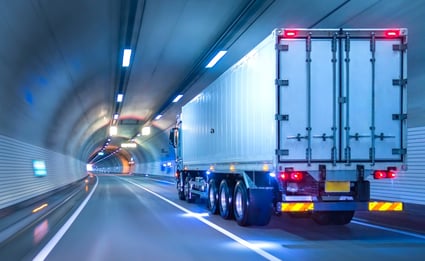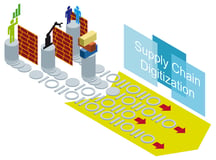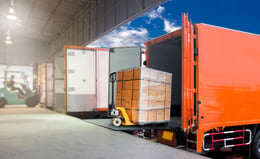5 Important Considerations for Smarter Route and Tour Planning
Brian Hoey - October 04, 2018

In theoretical computer science, the traveling salesman problem asks the following question: "Given a list of cities and the distances between each pair of cities, what is the shortest possible route that visits each city and returns to the origin city?" Anyone who has worked in transport logistics or transportation management knows that in most cases there is no easy answer to this question, and that finding the optimal route between different cities or even different stops along the same tour can be a serious logistical challenge—one that requires planners to manage customer delivery windows, anticipate traffic patterns, and optimize time and distance.
As we enter the so-called fourth industrial revolution and supply chain planning technology becomes more and more sophisticated, planners are increasingly being given the tools to tackle the traditional hurdles of route and tour planning (not just route optimization but capacity optimization, cost considerations, etc.) in a smarter, more agile way. With these new tools, from real-time supply chain information to 3D loading visualization, come a host of new considerations for how to plan routes and tours in the most efficient, cost-effective manner.
1. Optimization Parameters
As optimization tools become more and more sophisticated, transport planners will be able to optimize their plans by various different parameters like cost, total distance, and total time. As you develop your transport plans, you’ll have to choose which set of parameters best fits into your broader operational goals. If, for instance, you’re transporting goods that have a very short shelf-life to customers with flexible delivery windows, you might choose to prioritize speed over cost optimization in order to minimize the possibility of goods going bad before your customers can utilize them, thereby providing added value to your customers in the form of more flexible lead times on their end, for which they’ll thank you with continued loyalty. In this way, your transport logistics strategy becomes integrated more fully into your broader business goals (in this case building customer loyalty), decreasing the odds that transport processes will wind up at odds with longer term business objectives.
2. Production Chain Integration
Transport managers are able to glean more mission critical information from their and others’ production streams than ever before, but how can they adapt that information for their route and tour planning needs? For some businesses, for instance complex manufacturing outfits like automotive plants, there might be added value in loading goods into trucks in such a way as to correlate with your customers’ or your own production sequencing, i.e. grouping parts together not by type but by sequence so that they can be unloaded straight into production environments with maximum efficiency. This requires a high degree of data visibility and insight into the relevant planned production process, but it can bolster manufacturing efficiency and decrease container and warehouse requirements, thereby reducing costs and resource consumption. Conversely, a furniture manufacturer might offer assembly and delivery at the same time, meaning that planners would need to optimize both their time considerations and load strategies to account for this possibility. In both of these hypotheticals, the key thing to consider is that often the nature of the products that are being moved can and should inform your route planning.
3. Capacity Utilization
The question of whether to wait for a full truckload or to opt for milk runs has long been a matter of complex calculations. On the one hand, underutilizing your freight capacity can have a big impact on your bottom line in the long run. On the other, by insisting on a full truck load for every delivery, you lose out on a large degree of agility. How should businesses go about making that tradeoff in an optimal manner? Where, previously, these decisions would have necessarily been reached using past demand information, modern supply chain analytics and Industry 4.0 technology makes it possible to forecast demand more accurately on interrelated factors from tariffs to fuel prices. In this way, users can take a more informed approach to capacity utilization, making proactive scheduling decisions based on predictive algorithms that sense demand in advance—ultimately leading to a strategy that uses LTLs (less-than-full truckloads) in a dynamic fashion designed to add flexibility and thus value.
4. Real-time and Telematics Integration
IoT devices and RFID chips now make it possible to track shipments in real-time. To put this back in terms of the traveling salesman problem, this means that if traffic or weather conditions made one solution the clear favorite over another, you could adapt your existing route based on new information. Doing so would mean that your drivers are always using the most efficient, up-to-date routes, resulting in a higher rate of on-time deliveries. Think of this as the traveling salesman magically equipped with a walkie-talkie, connected to someone who can help him adjust his plans on the fly. The most significant hurdle here is putting systems in place that ensure that you’re able to communicate with your drivers about new information and changes to their route or the stops on their tours (which changes might result from a client unexpectedly cancelling an order, for instance) in a way that is safe and efficient. Luckily, most Industry 4.0 and Logistics 4.0 solutions can easily integrate with the telematics systems that are often used for driver communication. Combined with the real-time technology mentioned above, this creates an environment of increased connectivity, in which your fleet usage remains agile and adaptable even after the original plan has been put in motion.
5. 3rd Party vs. Owned Freight
This final consideration is aimed more at manufacturers than at logistics providers like shippers and freight forwarders. You need to move goods from your factory or warehouse to your customers; when should you use your own fleet of vehicles, and when should you rely on 3PLs (3 party logistics providers)? If your existing fleet doesn’t cover the amount of shipping capacity you need, when does it make sense to invest in more vehicles and when should you simply rely on a third party? Like many of the items on this list, this consideration has historically involved a fair bit of guesswork, with no easy solution either way. With Industry 4.0 analytics advancements, however, automotive plants and other manufacturers can easily utilize advanced predictive algorithms to visualize the short-, medium-, and long-term effects of adding more shipping capacity based on demand forecasts and intricate digital models of their existing supply chains. If your business were, for instance, considering additions to your existing fleet, you could run “what-if” scenarios on your existing operations to create side-by-side comparisons of the different options, giving you a degree of planning certainty that would have been hard to come by in a less connected environment.
In this consideration as in the previous four, shippers, manufacturers, and freight forwarders alike are faced with a choice. What were once difficult and sometimes intractable choices are becoming easier to optimize as the global supply chain continues to digitize and Logistics 4.0 continues to gain ground. By choosing to embrace the changing face of supply chain management, organizations can transform difficult problems in route and tour planning into value added propositions and drivers of future growth.
If you want to learn more get your Guide to Logistics 4.0
In this Guide you will learn:
-
Why a strategic process in transportation planning is a top priority for digitalization
-
What megatrends will increase supply chain volatility
-
How to manage it
LATEST POSTS
- Understand Circular Economy in The Manufacturing Industry
- How Can Industry 4.0 IT Integration Be Achieved Smoothly?
- The Significance of Order Sequencing in Discrete Manufacturing
- How to improve your Supply Chain Management: The Power of Control Towers
- Optimizing Human Resource Scheduling in Manufacturing: A Technological Approach



